This was published 6 years ago
Tips and things to do in Vietnam: 20 reasons to visit Hoi An
By Elspeth Callender
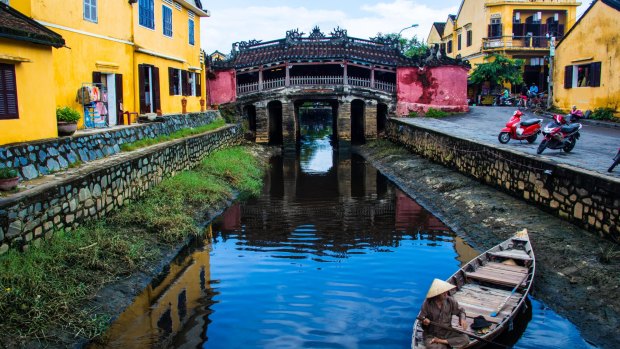
Japanese Bridge, Hoi An.Credit: Alamy
1. OLD TOWN
This ancient south-east Asian trading port turned fishing town in central Vietnam's Quang Nam province has been a UNESCO World Heritage Site since 1999, so it's far from lost to the homogenising consequences of modernisation. Step off the streets of the historic district into a light tourist scrum for a short guided tour through Tan Ky house to get a good look at the interior of one of the city's typical two-storey timber structures with its central courtyard open to the sky. The sixth and seventh generations of this 200-year-old family home reside on the upper floor.
2. PEOPLE
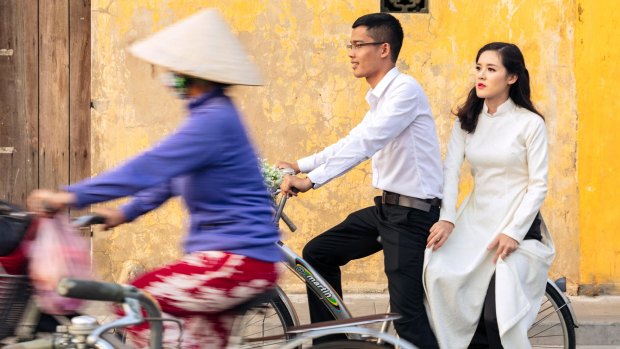
Locals on bicycles in the historic centre of Hoi An, Vietnam.Credit: Alamy
The name Hoi An means peaceful meeting place and it still feels that way all these many hundreds of years after the Cham people, of the former Kingdom of Champa, first began trading there in the seventh century. Today's 120,000 or so residents are generally more laid back and go to bed earlier than those of Vietnam's much larger centres such as Hanoi and Ho Chi Minh City. Nightlife, however, can be still found throughout the week in riverside bars while on Saturday evenings you can hear local vocal talent at Le Fe Cafeteria, (facebook.com/lefecafeteria) a few blocks back from the northern bank.
3. APPROPRIATION
Vietnam has been influenced by its enormous northern neighbour, China, for more than a thousand years of trading, migration, war and domination, and in Hoi An, there's obvious respect for red, a prevalence of yin-yang roof tiles and Confucius cups for sale around every corner. Elements of the city's architecture and food also reflect a long-term relationship with, amongst others, France and Japan. One particularly blatant act of fusion is the world's only Japanese covered bridge with a Buddhist temple attached.
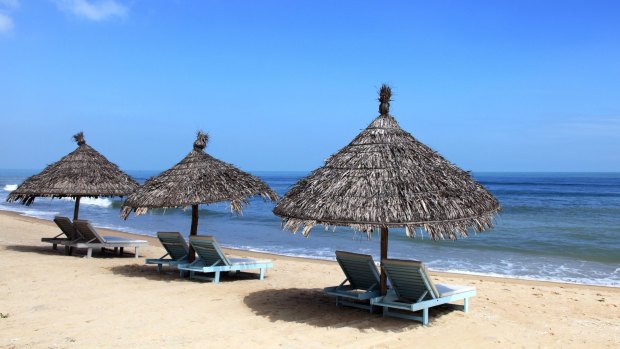
An Bang Beach, Hoi An, Vietnam.Credit: Alamy
4. WATERWAYS
Like the Venice of Vietnam, Hoi An is near the sea but most of the city is positioned across a series of rivers and canals. Braided at its mouth, Thu Bon intersects Old Town and a sunset boat ride on this river will give you a whole new perspective on the place. Every year during monsoon season Hoi An floods and the streets flow, so look out for watermarks on walls to see how high. The Chinese temple of Phuc Kien was originally built in 1697 as an assembly hall but is now dedicated to the worship of the goddess of the ocean, Thien Hau, who protects sailors.
5. LANTERN FEST
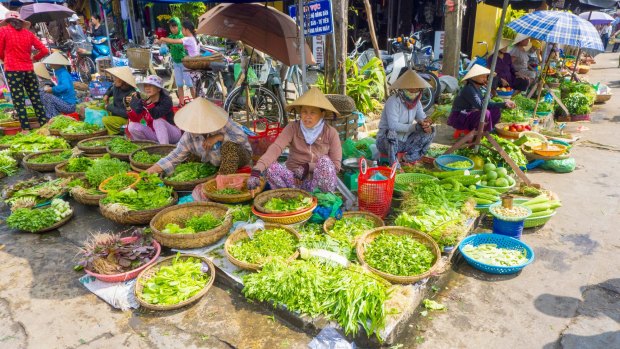
Street market in Hoi An.Credit: Alamy
Even when most of the city is sleeping the electric lanterns strung up on bridges and over roads and festooning the main intersections remain aglow. On the fourteenth day of every lunar month, when it's full moon, a festival is held in Hoi An and is a time locals and visitors light small paper lanterns and send them floating down the river.
6. BIKE CULTURE
Unlike Vietnam's larger cities, where scooters and cars rule, Hoi An is still into cycling. Motorised traffic is prohibited in Old Town from 9am-11am and 3pm-9:30pm, making these more relaxing times to get around by bicycle. The city streets are also quiet in the late evenings. Hotels like La Pavillon Hoi An Central Villa (lepavillonhoian.com) let their guests borrow bikes for free at any time of day or night and bicycle hire places in Hoi An also offer guided tours.
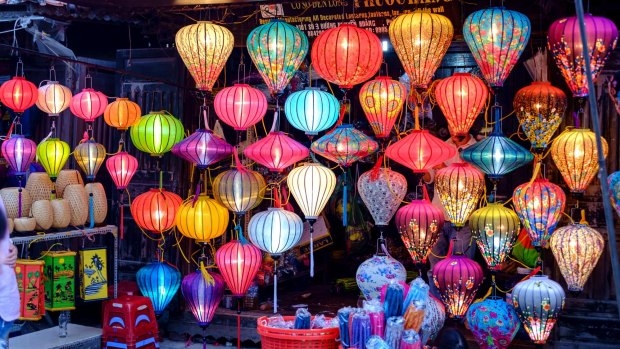
Paper lanterns for sale in Hoi An, Vietnam.Credit: Alamy
7. RAGE-FREE ROADS
Everywhere in the world has its own way of using their roads. In Hoi An there's a system you'll understand if you take the time to observe with an open mind. Part of that system includes not getting openly irate with those you're sharing the narrow streets with, and that is a beautiful thing.
8. TAILORS SWIFT
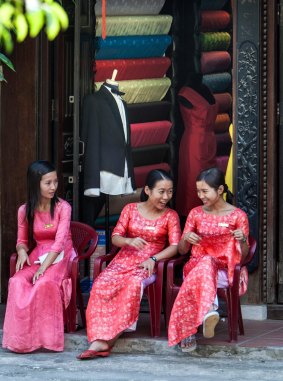
Young women sit outside a tailor shop in Hoi An.Credit: Alamy
Hoi An is full of tailors but, like anything anywhere, they aren't all of the same price range or standard. Yaly Couture (yalycouture.com) and A Dong Silk (adongsilk.com) are reputable high-end establishments who also sell specialist fabric. For something more cheap and cheerful, Be Be Tailor (bebetailor.com) has three shops and a very good reputation. Tony the Tailor, a little out of the way at 294 Nguyen Duy Hieu, is great for suits. Expect a fairly fast turnaround from everyone.
9. CERAMICS
If you like the old stuff, the Museum of Trade Ceramics exhibits a large range of eighth to eighteenth century pottery from China, India, Japan, the Middle East and Thailand. Be aware many artefacts on display in this museum were recovered in local archaeological digs and are shards and slithers rather than intact pieces. See hoian-tourism.com
10. SMELLS
Embracing the scents of a place is an important part of immersing yourself in somewhere new and Hoi An's smells change with just about every step. Especially in the marketplace.
11. CENTRAL MARKET
The city might be touristy but undercover food market Cho Hoi An doesn't pander to that group. Street food at its best, the piled-high ingredients for banh xeo (crispy pancake with turmeric), the wontons, salad, water spinach, green beans, shrimp and pork dumplings, chunks of cured pork and noodles could hardly look fresher and more inviting to order. Especially in the morning light.
12. CAO LAU
The thick yellow oiled noodles of this famous Hoi An dish, which was developed during the eighteenth century, are made daily by hand in the early hours of every morning. Traditionally, the water for making cao lau came from a specific local well and the ash for purifying that water from a nearby island but this isn't practical anymore. When you order cao lau, the noodle is thrown together with salted pork and a bit of boiling broth. Add chilli sauce.
13. WHITE ROSE
Although cao lau is Hoi An's signature dish it's likely the white rose dumpling will steal your heart. Delicate and soft, these single mouthfuls of rice paper, fried garlic and onion, peanuts, fish sauce and a touch of pork or shrimp will melt in your mouth and send your eyes involuntarily rolling back in your head.
14. BANH MI
Some leave breadcrumbs as they go while the French have left a trail of baguettes and pate in their postcolonial wake. At lunchtime, line up at the busiest banh mi joint you can find and make sure you get a big smear of pig's liver pate on your bun.
15. FRESH FRUIT
Things change with the seasons but, in February for instance, you'll find jackfruit, mandarin, passionfruit, dragon fruit, durian, banana, custard apple, lychee, rambutan, longan and imported apples and pears in the market.
16. FUNKY EGGS
Tired of poached, fried or scrambled? In Hoi An you can try balut – a developing duck embryo boiled in its own shell. Or trung bach thao – a preserved unfertilised duck egg that ends up with a black yolk and local eat them with pepper and salt.
17. GETTING YOUR FIX
Whether it's coffee, IPA, beetle nut or sticky rice with coconut and sugar you crave, you'll easily find it in Hoi An. There are now European-style cafes, such as Hoi An Roastery (hoianroastery.com), but if you really want to elicit a genuine smile from a local then find a hole-in-the-wall eatery and order a "Vietnamese coffee" to be enjoyed in all its condensed milk glory.
18. THE HEAT
Central Vietnamese people like it hot so everything's served with chilli sauce on the side. In Hoi An this is often the consistency of jam and should be generously added to every savoury edible. Many local families pass their recipe down through generations, Hoi An chilli sauce is in demand in other parts of Vietnam and also gets shipped around the world.
19. PREDICTABLE WEATHER
Hoi An has wet and dry seasons. The rains fall from October to December and monsoon flooding is a part of life. The temperature is highest from May to August, sometimes up to 38 degrees Celsius, while April is variable and February and March just right.
20. BEACHES
The beach you pass on the road between Da Nang airport and Hoi An was formerly known as China Beach but things got awkward with that northern neighbour over the name so it's now Da Nang Beach. An Bang Beach is only five kilometres from Hoi An's Old Town but feels like another world.
Elspeth Callender travelled as a guest of Webjet Exclusives.
Sign up for the Traveller Deals newsletter
Get exclusive travel deals delivered straight to your inbox. Sign up now.